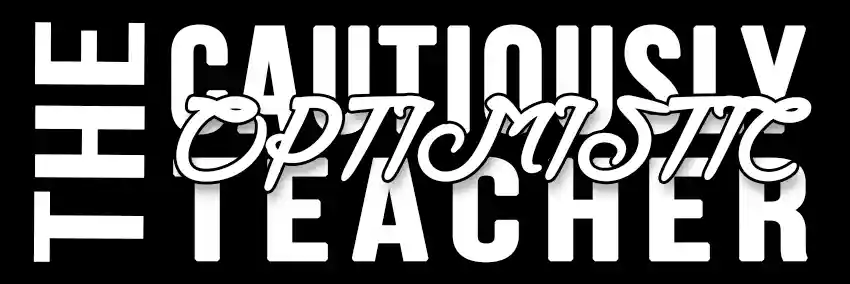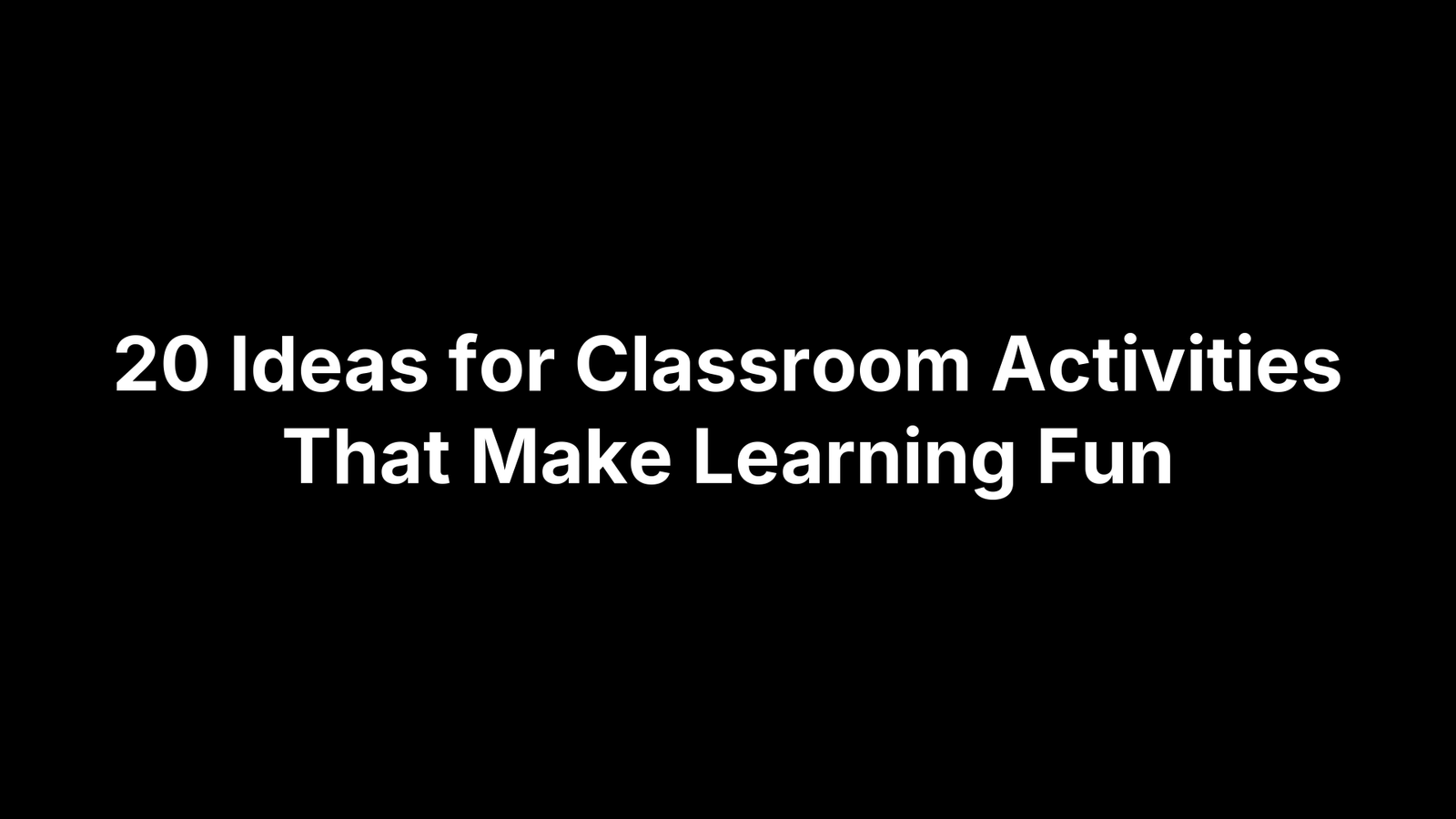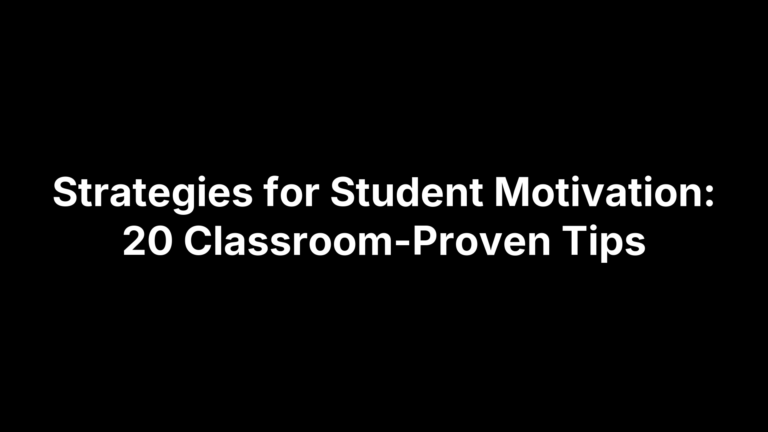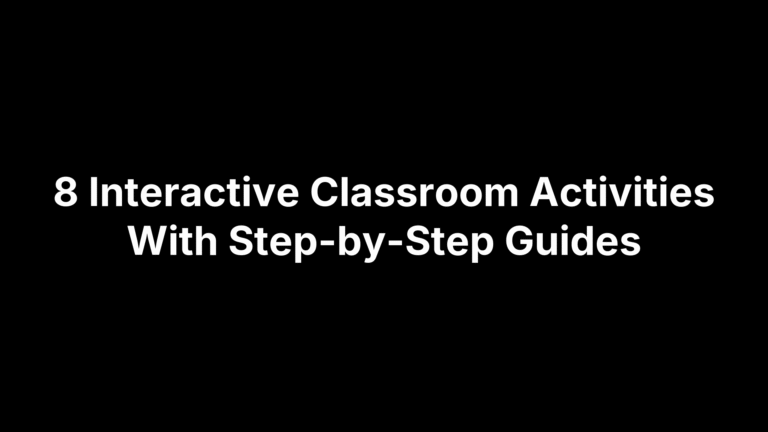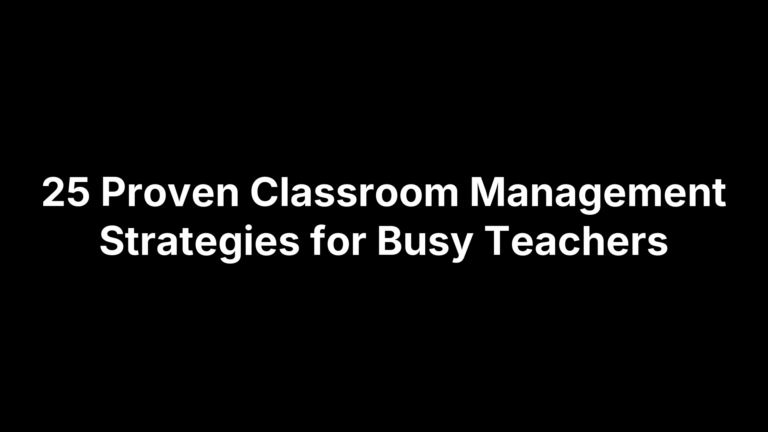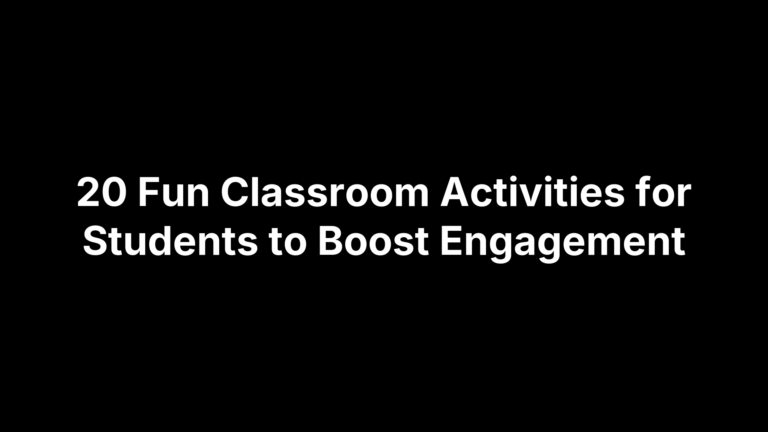20 Low-Prep Classroom Activity Ideas to Boost Engagement
Your lesson has five minutes left and energy is fading fast. Rather than scramble for another worksheet, imagine pulling a single activity from your back pocket that jolts students awake, sparks real thinking, and requires almost zero setup. That’s exactly what this guide delivers: 20 classroom activities tested by teachers, adaptable for any grade from third period math to senior English, and friendly to tight budgets and tech-restricted rooms.
Each idea comes with clear objectives, quick steps, and tweaks for class size, subject, and available devices, so you can scan, pick, and teach without a weekend of planning. You’ll find movement breaks that double as formative checks, low-stakes debates that sharpen reasoning, and game-style reviews students beg to repeat. By the end, you’ll have a fresh toolkit that balances collaboration, creativity, critical thinking, and technology—ready to make Monday feel a lot less Monday. Let’s get started and transform class time.
1. Mystery Envelope Bell Ringer
Hook students instantly with a sealed envelope of clues tied to today’s topic.
Purpose & Learning Targets
- Spark prior knowledge and curiosity in 5 min
- Reinforce prediction, inference, and questioning skills
Step-by-Step Implementation
- Fill envelopes with 2–3 related clues
- Students glance/feel for 45 s, clipboard walk
- Share “I predict…” statements before opening
Tips & Variations
- Digital lock Google Form version
- QR codes for multimedia hints
- Exit ticket: Which clue mattered most?
2. Think-Pair-Share Remix
Give the classic strategy a makeover by adding a second partner swap, turning a quiet think-time into a mini-network of ideas that scales from six students to sixty.
Why It Engages
- Private processing lowers anxiety before speaking
- Peer rehearsal builds confidence and clarity
- Partner swap exposes learners to multiple viewpoints in minutes
Implementation Guide
- Pose an open-ended, standards-aligned question.
- Students think silently for 30–60 s, jotting on mini whiteboards.
- Pair up to discuss; after 1 min, cue a quick “musical chairs” partner change for a fresh exchange.
- Volunteers—or a cold-call wheel—share synthesized answers with evidence.
Extension Options
- Require each share to include a direct quote, diagram, or data point.
- Collect whiteboards for a lightning-fast formative check.
- Let students submit lingering questions to a digital parking lot for follow-up.
3. Four Corners Debate
When the room needs movement and meaningful talk, shift discussion to the walls with a quick Four Corners debate.
Objectives
- Encourage active listening and rebuttal
- Practice evidence-based argumentation
- Provide kinesthetic brain break
Setup & Process
- Label corners Strongly Agree, Agree, Disagree, Strongly Disagree.
- Read provocative unit statement; students move accordingly.
- In corners, discuss reasoning, then spokesperson shares.
Differentiation & Assessment
- Offer sentence starters or printed facts for ELLs/introverts.
- Quick exit reflection: note if stance shifted and why.
4. Brainstorm Carousel
Brainstorm Carousel turns wandering conversations into focused, fast-moving idea generation that leaves no student on the sidelines.
Goal
- Generate abundant ideas rapidly
- Ensure equal participation from every voice
How It Works
- Post chart paper with concise prompts around the room.
- Groups rotate every two minutes, adding or starring new ideas.
- Teams return to their original poster, distill notes, and present the top three takeaways.
Classroom Management Hacks
- Play music as a built-in timer.
- Color markers to track which group contributed where.
5. Classroom Jeopardy Quiz Show
Nothing wakes a sleepy class faster than hearing the Jeopardy theme and seeing categories that mirror tomorrow’s test.
Engagement Rationale
- Gamification sparks recall and collaboration.
Preparation & Play
- Create a five-category board with tiered point values.
- Split class into teams; highest point total wins bragging rights.
- Add one Daily Double and a written Final Jeopardy wager.
Variations
- Student-written clues deepen ownership.
- “Beat the Teacher”: class score vs. yours.
- No tech? Use sticky notes on the board.
6. Escape Room Challenge
Transform your classroom into a timed puzzle zone that fuses content review with adrenaline. Students collaborate, crack codes, and race the clock to “escape,” making it one of the most memorable ideas for classroom activities you’ll ever run.
Purpose
- Boost teamwork, critical thinking, and urgency.
Design Blueprint
- Tie each puzzle to a learning standard—
Caesar cipherreveals the next math step. - Supply combination locks or Google Form sections; post clear win conditions.
- End with a five-minute class debrief on strategies and misconceptions.
Low-Tech Option
Envelope clues hidden under desks and furniture lock symbols replace digital devices perfectly.
7. Station Rotation Circuit
When the class needs variety but you still want tight control of timing, a station rotation circuit breaks the period into bite-sized, purposeful chunks that keep everyone moving and mastering content.
Why It Works
- Built-in movement refreshes focus
- Chunked tasks aid attention and retention
- Teacher station allows on-the-spot differentiation
Setup Steps
- Create 3–5 stations: mini-lesson, tech exploration, collaborative apply, independent practice, reflection.
- Post a visual timer and rotation map; plan 10–12 minutes per stop.
- End with an exit slip or quick digital check to capture learning evidence.
Management Tips
- Color-code groups and station signs for smoother transitions.
- Pre-record instructions so students start immediately while you coach individuals.
- Keep one “flex station” open for catch-up or enrichment to prevent bottlenecks.
8. Gallery Walk Peer Review
Turn your classroom walls into a living rubric. A gallery walk sends students on a silent tour of peers’ work, prompting focused observation and quick, actionable feedback that writers, designers, or problem-solvers can revise the same day.
Objectives
- Strengthen critique skills and content ownership
- Expose students to diverse approaches and solutions
Procedure
- Post student products (posters, equation proofs, essay drafts) around the room.
- Hand out feedback sheets or color-coded sticky notes: green = praise, yellow = question, pink = polish.
- Students circulate silently for 8–10 min adding notes, then regroup for open discussion and clarifications.
Extension
- Compile a “Top Takeaways” chart as a class and ask each creator to choose one suggestion to implement before final submission.
9. Hot-Seat Role-Play Interviews
Hot-seat interviews turn classmates into journalists grilling a character, boosting speaking skills and content mastery in minutes. One student embodies a historical figure, literary protagonist, or scientist, while peers fire off evidence-seeking questions.
Learning Aims
- Empathy through perspective-taking
- Inquiry with purposeful questions
- Evidence-based speaking & listening
Execution
- Assign a volunteer to portray a curriculum figure.
- Students write two probing questions each.
- Hold four-minute press conference; answers must reference a specific fact or quote.
Assessment
- Quick rubric: accuracy, depth, delivery.
- Audience submits one standout answer to verify attentive listening.
10. Collaborative Story Chain
Collaborative Story Chain turns blank pages into shared, fast-paced adventures students can’t wait to continue.
Purpose
- Boost writing fluency, creativity, and audience awareness in five minutes.
How to Run
- Display an engaging prompt.
- Students write 2 min, then pass notebook/device right.
- After 4–6 passes, originator reads the final story aloud.
Options & Tech
- Shared Google Doc with “anonymous animals” lets everyone edit live.
- Hard mode: each turn must use the day’s vocab word or a
figurative_languagedevice.
11. Limited-Materials Design Sprint
A Limited-Materials Design Sprint has teams invent new products from a single, ordinary classroom supply.
Concept
Encourages divergent thinking and lightning-fast prototyping.
Steps
- Reveal one mystery material—paper clips, rubber bands, or straws.
- In eight minutes, teams brainstorm as many uses as possible.
- Choose the strongest idea; build or sketch a 60-second demo and present.
Reflection
Debrief: how did scarcity fuel creativity, and where could ideas apply?
12. Sketchnote Summary Sheets
Sketchnoting converts dense notes into colorful one-page comics students love.
Learning Targets
- Dual-code information for stronger memory
- Force concise summarizing and concept connections
Implementation
- Teach five basic icons and connectors.
- Model turning a paragraph into visuals live.
- Students craft a sheet during wrap-up.
Adaptations
- Provide templated frames for beginners or IEP accommodations.
- Allow digital tablets or auto-drawing apps for art-savvy learners.
13. Academic Olympics
Academic Olympics makes test review feel like field day, mixing mental sprints with low-risk competition that livens up even the last period.
Engagement Rationale
Movement plus game mechanics spikes energy and long-term recall.
Setup
- Arrange 4 themed stations: Grammar Javelin, Math Relay, Science Long Jump, History Hurdles.
- Teams rotate every 4 min, scoring for speed and accuracy.
- Record totals on a scoreboard app or simple whiteboard.
Safety & Inclusivity
- Include seated challenges and celebrate personal bests to keep competition friendly.
14. Silent Chalk Talk
Silent Chalk Talk is one of those ideas for classroom activities that hands the marker to every learner while keeping the room pin-drop quiet.
Objective
- Give quiet students equal voice
- Reveal misconceptions in real time
How It Works
- Write the essential question mid-page; add markers around.
- Students circulate 5 min writing comments, starring ideas, drawing connections—strictly silent.
Debrief
- Wrap up aloud, spotlight key themes.
15. Walking Question Trail
Turn the hallway—or an outdoor path—into a pop-up review by posting numbered prompts that students answer while literally on the move.
Purpose
- Mix movement and content talk
- Quick formative snapshot
- Encourages peer coaching
Steps
- Post ten question cards around route.
- Pairs walk, discuss, jot answers.
- End with self-check or debrief.
Variation
- QR codes add video clues.
16. Peer-Taught Mini-Lessons
Handing the marker to students proves they know the material. In this fast-cycle mini-lesson format, every learner becomes teacher and audience—one of the slickest ideas for classroom activities when you’re short on prep time.
Why It Works
Peer teaching tops ideas for classroom activities; retrieval plus explanation boosts encoding.
Implementation
- Assign bite-size topics and a graphic organizer.
- Teams craft a 5-minute lesson: hook, clear model, 30-second check.
- Rotate stations; observers fill a two-prompt feedback checklist.
Support
- Share rubric and slide deck template.
- Mini-coaching on voice, timing, and transitions.
17. Fishbowl Socratic Seminar
Fishbowl Socratic Seminar spotlights deep dialogue by seating a few speakers in an inner ring while peers observe, score, and later swap roles.
Objectives
- Practice text-based questioning
- Strengthen active listening
- Encourage self-reflection on discussion
Procedure
- Inner circle debates teacher-given prompt.
- Outer circle tallies evidence and questioning moves.
- Groups switch; whole class writes reflection.
Tips
- Provide sentence stems for hesitant speakers.
- Track questions vs. statements on a live board.
18. Digital Choice Boards
Digital choice boards hand learners the remote, allowing them to decide whether they’ll demonstrate mastery through a meme, screencast, podcast, or infographic—while you still hit the same standard for everyone.
Purpose
- Build autonomy and motivation by giving students curated, meaningful options
- Ensure all tasks map to the identical learning target
Setup
- Design a 3×3 grid labeled Create, Analyze, Apply.
- Post it in Slides, Canva, or your LMS with live links and rubrics.
- Students pick one square from each column, then submit work in a single showcase thread.
Differentiation
- Shade squares for difficulty levels; students must include at least one “stretch” task.
- Let learners pitch their own square for teacher approval, fostering voice and choice even further.
19. Gamified Progress Quest
Gamified Progress Quest turns routine work into an adventure where students earn XP, level up, and unlock classroom perks.
Why Students Love It
- Visible badges make effort real.
- Solo or team modes fit all.
How to Launch
- Define checkpoints for each learning target; assign XP values.
- Track scores on a shared spreadsheet or poster.
- Celebrate level-ups with non-material rewards like music choice or a homework pass.
Pitfalls to Avoid
- Keep the XP curve attainable; frustration kills motivation.
- Post scores privately to avoid shaming.
20. Service-Learning Project Pitch
Learning Goals
- Connect academic content to authentic community needs
- Develop research, persuasion, and civic-mindedness
Steps
- As a class, brainstorm local issues linked to your unit (e.g., water quality in science).
- Teams research root causes, craft an actionable solution, and design a 3-minute multimedia pitch.
- Present to a panel of administrators, parents, or community partners for feedback and potential implementation.
Reflection & Assessment
- Students journal their takeaway on social impact and personal growth; rubric scores depth of research, feasibility, and persuasive delivery.
Keep the Momentum Going
Twenty quick-fire ideas for classroom activities now sit in your toolkit, and each one layers movement, collaboration, creativity, technology, and student voice into everyday lessons. Pick a single strategy for tomorrow’s opener, or stitch three together for a full period of purposeful energy.
Remember the common threads:
- Low prep, zero pricey materials
- Built-in formative assessment
- Flexible for any grade or content area
- Adaptable for no-tech, one-device, or 1:1 environments
If you’re hungry for ready-made templates, step-by-step planners, or the AI tools that auto-differentiate groups in seconds, swing by The Cautiously Optimistic Teacher. We’re adding fresh resources weekly so momentum—and student engagement—never flatlines.
